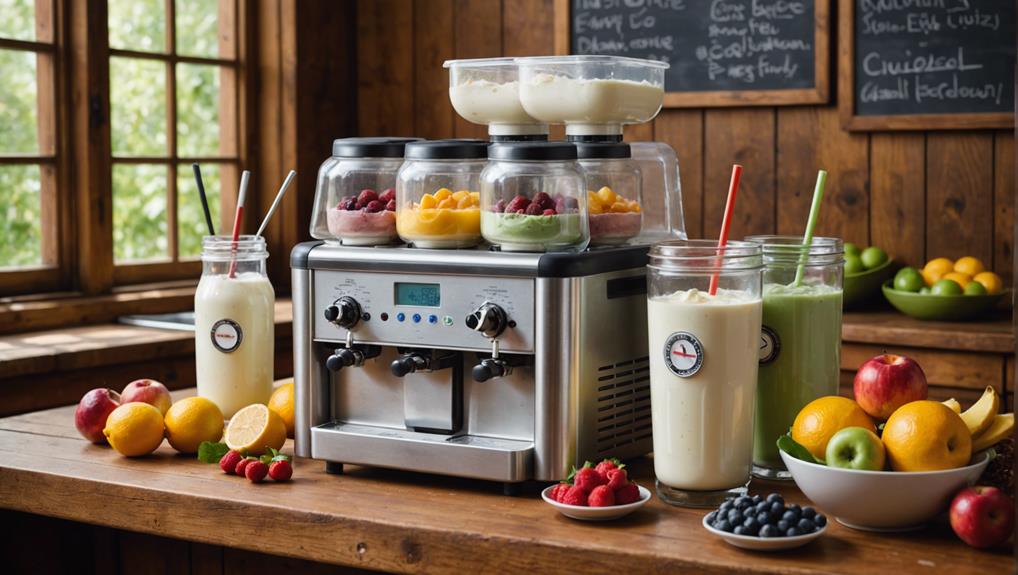The pH of frozen yogurt greatly impacts its taste, texture, and probiotic viability. Ideal pH levels, typically between 4.0 and 4.6, enhance tanginess and balance sweetness, ensuring consumer satisfaction. The pH influences protein structure, thereby affecting texture and mouthfeel. Precise pH control is vital during fermentation, as it promotes probiotic activity and stability. Regular monitoring with a calibrated pH meter is essential to maintaining product quality and consistent sensory attributes. Achieving an ideal pH level is essential for balancing taste, texture, and health benefits in frozen yogurt. For a deeper understanding, further details are available on the intricate effects of pH.
Key Takeaways
- Lower pH enhances the tanginess and improves the flavor profile of frozen yogurt.
- Proper pH control is essential for achieving a smooth and creamy texture.
- Ideal pH levels support the viability of probiotics, maintaining health benefits.
- Continuous pH monitoring ensures consistent fermentation and high-quality frozen yogurt.
- Consumer preference for pH ranges between 4.0-4.6 guarantees taste satisfaction.
Understanding Ph in Yogurt

The pH level in yogurt, particularly frozen yogurt, is a critical parameter that influences its taste, texture, and probiotic viability. During the fermentation process, lactic acid bacteria metabolize lactose present in dairy products, resulting in the production of lactic acid. This biochemical activity causes a decrease in pH, a key factor in determining yogurt's characteristic tanginess and consistency.
In frozen yogurt, maintaining an ideal pH balance is essential not only for taste but also for the viability of probiotic bacteria. Probiotics are introduced to enhance gut health and contribute to the overall nutritional profile of the product. However, the freezing process poses a challenge to the survival of these beneficial bacteria, as it can impact both their viability and the product's pH balance.
Moreover, the substitution of milk fat with inulin—a common practice in modern frozen yogurt formulations—can further decrease the pH, potentially altering the product's stability and probiotic efficacy. Understanding these pH dynamics is important for food scientists and manufacturers aiming to guarantee the quality and health benefits of frozen yogurt. Rigorous monitoring and control of the pH level throughout production are imperative for delivering a consistent and health-promoting product.
Effects on Taste
Lowering the pH levels in frozen yogurt greatly enhances its tanginess, thereby influencing the overall taste profile and consumer preference. The increased acidity at lower pH levels sharpens the taste perception, creating a more pronounced tang that appeals to a significant segment of consumers. This heightened acidity, however, must be balanced carefully with sweetness to achieve an ideal flavor profile.
Data indicates that pH levels between 4.0 to 4.5 are ideal for maintaining the desirable balance between tanginess and sweetness in frozen yogurt. At this pH range, the acidity is sufficient to enhance the yogurt's distinctive tartness without overpowering its natural sweetness. Such a balance is crucial for achieving consumer satisfaction and ensuring a positive sensory experience.
Furthermore, maintaining the optimal pH is essential not only for flavor but also for product development. A stable pH contributes to consistent taste profiles across production batches, thereby improving the reliability and quality of the final product. Consequently, understanding and controlling pH levels is crucial for developing frozen yogurt that meets consumer expectations, both regarding taste and overall satisfaction. This meticulous approach guarantees the frozen yogurt remains a preferred choice among its target market.
Texture and Consistency

The pH of frozen yogurt plays a crucial role in determining its texture and consistency, primarily through its influence on protein structure and ice crystal formation. Acidic conditions can denature proteins, resulting in a smoother texture, while alkaline conditions may lead to coarser textures due to protein aggregation. Additionally, ideal pH levels help control ice crystal size during freezing, which is essential for achieving a creamy consistency and enhancing overall product quality.
Protein Structure Changes
Modulating the pH levels during frozen yogurt production directly impacts the protein structure, consequently altering its texture and consistency. The pH levels influence the interaction between casein micelles and whey proteins, which are critical components in frozen yogurt. Proper pH control is paramount for achieving the desired gelation properties, which subsequently affect the firmness and mouthfeel of the product.
At ideal pH levels, proteins exhibit enhanced gelation properties, leading to a smoother and creamier texture. Deviations from this ideal pH can disrupt protein interactions, resulting in a less desirable texture and consistency. For instance, lower pH levels can cause excessive protein denaturation, leading to a firmer, more brittle structure, while higher pH levels might result in insufficient protein network formation, causing a runny and inconsistent product.
Scientific studies have demonstrated that maintaining an ideal pH range (typically around 4.5 to 4.8) is essential for optimizing the sensory attributes of frozen yogurt. This careful balance ensures the product retains its characteristic smoothness and creaminess, thereby enhancing consumer satisfaction. Understanding the intricate relationship between pH and protein structure is critical for producing high-quality frozen yogurt with consistent texture and mouthfeel.
Ice Crystal Formation
Achieving ideal ice crystal formation in frozen yogurt is essential for maintaining its desired texture and consistency, with pH levels playing a critical role in this process. Lower pH levels are associated with the production of smaller ice crystals, which contribute to a smoother and creamier texture. This phenomenon is primarily due to freezing point depression, where the reduction in pH lowers the freezing point of the mixture, thereby influencing the size and distribution of ice crystals during the freezing process.
Control over pH is vital for optimizing the mouthfeel and sensory attributes of frozen yogurt. A lower pH can prevent the development of an icy or grainy texture, which is often perceived as undesirable by consumers. Consistent management of pH levels ensures that ice crystal formation remains within the ideal range, thereby enhancing the overall quality of the product.
The interplay between pH and ice crystal formation underscores the importance of precision in frozen yogurt production. By methodically adjusting pH levels, manufacturers can fine-tune the texture and consistency of the final product, ultimately delivering a superior sensory experience that meets consumer expectations.
Fermentation Process
The fermentation process in frozen yogurt is crucial for achieving ideal pH levels, which are primarily influenced by the activity of bacterial cultures producing lactic acid. Maintaining a pH conducive to probiotic viability is essential for both the health benefits and the sensory attributes of the product. Data indicates that variations in ingredients, such as the incorporation of inulin or coconut flour nanoparticles, can greatly impact the pH and overall fermentation efficiency.
Ideal Ph Levels
Understanding the ideal pH levels during the fermentation process is essential to guaranteeing the optimal growth of beneficial bacteria and achieving the desired texture and flavor in frozen yogurt. Typically, the pH levels should range between 4.0 and 4.5. This specific range facilitates lactic acid production, which is vital for lowering the pH and promoting the viability of probiotic cultures. The resulting acidic environment supports the proliferation of beneficial bacteria, contributing to the health benefits and sensory properties of frozen yogurt.
The type of milk used in the formulation greatly influences pH levels. For instance, different milk sources, such as cow, goat, or plant-based alternatives, possess varying initial pH values, which can impact the overall fermentation process. Additives, including stabilizers and sweeteners, also play a role in modulating pH levels. These components can either buffer the acidity or accelerate the acidification process, impacting the final texture and flavor profile.
During fermentation, continuous monitoring of pH levels is imperative. A deviation from the ideal range can result in suboptimal bacterial growth, compromising both the probiotic benefits and the sensory attributes of the frozen yogurt. Hence, maintaining precise pH control ensures a high-quality product.
Bacterial Culture Activity
Monitoring and controlling pH levels during fermentation are crucial, as bacterial culture activity intricately influences the acidification process in frozen yogurt production. The bacterial cultures employed convert lactose into lactic acid, thereby reducing the pH of frozen yogurt, which is a critical factor in texture development and microbial viability. The fermentation process is meticulously regulated to maintain ideal pH levels, guaranteeing the production of high-quality frozen yogurt with desired taste and texture.
Probiotic strains are often incorporated into frozen yogurt, enhancing its health benefits while also assisting in pH regulation. The interplay between bacterial cultures and pH levels is essential for achieving consistent fermentation outcomes. Proper pH management fosters an environment conducive to the activity of these cultures, resulting in the effective breakdown of lactose and the formation of lactic acid. This not only impacts the sensory properties of frozen yogurt but also ensures the viability of beneficial microbes.
| Parameter | Ideal Range | Impact on Frozen Yogurt |
|---|---|---|
| pH Levels | 4.0 – 4.5 | Texture and taste |
| Lactose | 4-6% | Substrate for fermentation |
| Lactic Acid | 0.7 – 1.1% | Acidification and flavor |
| Probiotic Viability | ≥ 10^6 CFU/g | Health benefits |
| Fermentation Time | 4-6 hours | Consistent acidification & texture |
Ph Measurement Techniques

Accurate pH measurement in frozen yogurt production is achieved through the utilization of a calibrated pH meter, ensuring precise monitoring of acidity levels. pH measurement techniques are integral to maintaining the ideal balance between acidity and alkalinity in frozen yogurt, which typically has a pH range of 4.0 to 4.6. This slightly acidic environment is essential for the texture, taste, and overall quality of the product.
The pH meter serves as an indispensable tool in the production processes, facilitating the assessment of pH levels that directly influence the viability of probiotic bacteria, which are vital for the health benefits associated with frozen yogurt. Additionally, consistent pH monitoring is pivotal for preserving the sensory attributes and extending the shelf-life of the product.
To underscore the importance of pH measurement, consider the following points:
- Texture: Proper pH levels ensure the desired creamy texture.
- Sensory Attributes: Maintains the balance of flavor and tartness.
- Probiotic Bacteria Viability: Ensures a conducive environment for beneficial bacteria.
- Shelf-Life: Accurate pH levels help in prolonging product stability and safety.
Maintaining Ideal Ph
Maintaining the ideal pH in frozen yogurt production is essential for optimizing fermentation, guaranteeing proper texture, and supporting probiotic viability. The target pH level of approximately 4.65 is key for the effective fermentation process, which directly affects the texture and the survival of beneficial bacteria. Variations in pH levels can greatly impact the physicochemical properties of the final product.
Incorporating coconut flour nanoparticles has shown to enhance the physicochemical properties of frozen yogurt. These nanoparticles can influence pH levels, requiring careful monitoring to maintain the most suitable range. Moreover, the replacement of milk fat with inulin is another strategy employed in frozen yogurt production. This substitution generally results in a decrease in pH due to inulin's inherent characteristics, necessitating adjustments in the formulation to uphold the ideal pH.
During the freezing process, maintaining consistent pH levels is vital to preserving probiotic viability and achieving the desired texture. Fluctuations in pH can compromise the integrity of probiotics, diminishing their health benefits. Methodical analysis and precise monitoring of pH levels throughout production ensure the quality and efficacy of frozen yogurt, aligning with industry standards and consumer expectations.
Consumer Preferences

Consumer preferences for frozen yogurt are markedly influenced by pH levels, with a common preference for the balanced acidity found within the 4.0-4.6 range. This specific pH interval is often associated with ideal tartness, providing a taste that aligns well with market demands for both tanginess and sweetness. Studies indicate that the majority of consumers favor a pH of approximately 4.2, a point at which acidity and sweetness strike a harmonious balance, thereby maximizing consumer satisfaction.
The influence of pH levels on consumer preferences can be summarized as follows:
- Taste Preference: A pH range of 4.0-4.6 is preferred, offering a balanced acidity that enhances the taste profile of frozen yogurt.
- Tanginess: Lower pH levels contribute to increased tartness, which is a key factor in consumer perception and overall liking of the product.
- Market Demands: Manufacturers can tailor frozen yogurt formulations to meet market demands by targeting the preferred pH range, thereby enhancing consumer satisfaction.
- Consumer Surveys: Data from consumer surveys consistently show a preference for a pH around 4.2, highlighting the importance of balanced acidity in frozen yogurt.
Understanding these preferences allows manufacturers to optimize their products, ensuring they meet consumer expectations for taste and tanginess.
Frequently Asked Questions
How Does Ph Affect Yogurt?
pH greatly influences yogurt's acid balance, flavor profile, and texture development. It affects bacterial growth, nutrient retention, and the fermentation process, impacting taste quality and shelf life. Starter culture and temperature control are vital factors.
What Is the Ph of Frozen Yogurt?
Balancing the delicate dance of flavor profiles, the pH of frozen yogurt typically ranges from 4.0 to 4.6, influenced by ingredient quality, storage methods, and sweetening agents, ensuring peak probiotic benefits and maintaining texture variations and color stability.
What Is the Ph of Yogurt Culture?
The pH of yogurt culture typically ranges from 4.0 to 4.6, influenced by lactic fermentation, starter culture, bacterial strains, and temperature control during the dairy fermentation and incubation process, creating an acidic environment crucial for peak microbial activity.
Why Did the Ph of the Milk Decrease During the Production of Yogurt?
During yogurt production, the pH of milk decreases due to the fermentation process where starter cultures induce bacterial activity, breaking down lactose into lactic acid. This acid production coagulates milk proteins, enhancing texture and flavor changes.
Conclusion
The intricate dance of pH within frozen yogurt not only shapes its taste profile and texture but also orchestrates the fermentation process, thereby dictating its overall quality. Measurement techniques and rigorous maintenance of ideal pH levels form the bedrock of producing a superior product. A deeper comprehension of consumer preferences, intertwined with methodical pH management, guarantees that the final offering is both scientifically sound and palatably enchanting. The balance of pH is the unseen maestro in the symphony of frozen yogurt creation.







